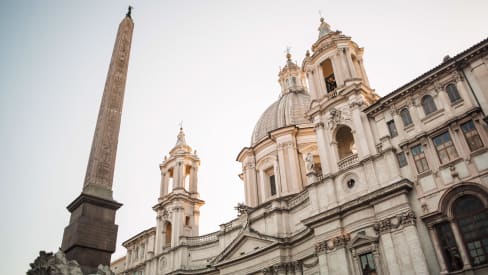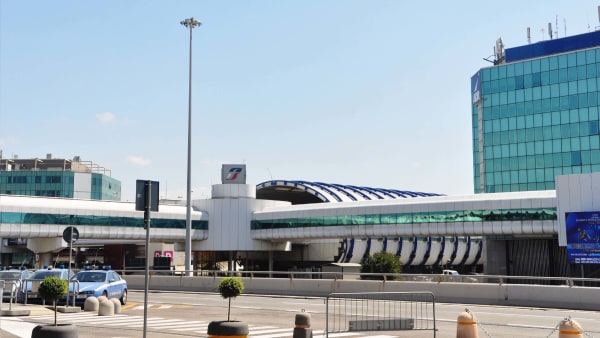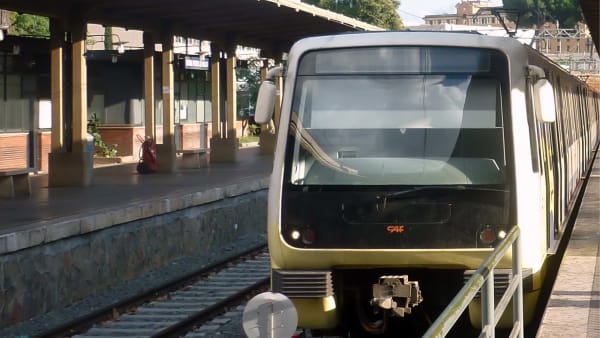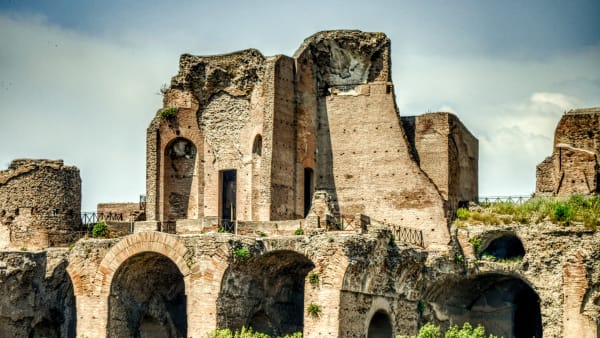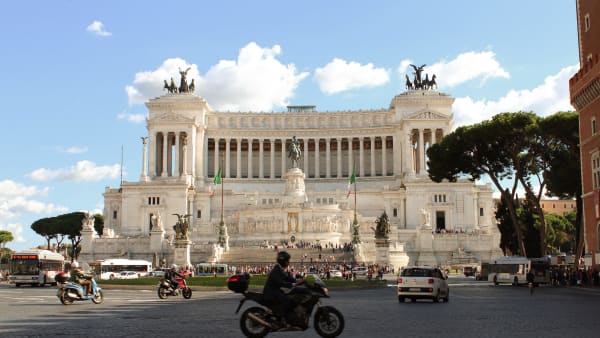Brief history
Brief history
Domitian’s stadium was built on the southwestern edge of the Campo Marzio district, next to the Neronian baths and Agrippa’s stadium. It was the place where the Roman people engaged in sports, competition, and recreation. It eventually remained in use until the 4th century.
Imperial period (27 BC - 476 AD)
As mentioned in the introduction, today’s Piazza Navona originated from a stadium that was probably built by Domitian before 86 AD. Its purpose was to host the Greek athletic games which he particularly valued. The Romans instead, didn’t like the games and considered them immoral.
The structure had two main entrances in the middle of the long sides, and another in the middle of the curved side. On the outside, the façade consisted of two orders of arches resting on columns of travertine with Ionic half-columns in the first order and Corinthian columns in the second. It was built of travertine blocks and bricks, covered with colored plaster, and is the only example of a masonry stadium known to date in Rome.
The games mentioned above were called “agones” and the name of the square is derived from this term: “in agone” means “through the games”.
The stadium was richly decorated with statues, including that of Pasquino, which now stands at Piazza di Pasquino (next to Piazza Navona).
Since it was more a stadium rather than a real circus, there were no carceres (the gates from where the racehorses came out) and it neither had a spina (the dividing wall around which the horses would run) as, for example, in the Circus Maximus. Instead, the space was used for sports competitions. The obelisk, which today stands in the center of the square, came from the Circus of Maxentius, which is still located on the Via Appia.
Middle Ages (476 - 1492)
Starting in the Middle Ages, a series of small houses began to be built on the site of the former stadium stands, while the central court (where the actual games took place) remained empty and became a place for trading.
The square saw the construction of stalls and inns in the area corresponding to the arches, as well as underground chambers that hosted brothels. This area thus became known for its disreputable and shady visitors.
Around the year 1000, the stadium was still entirely closed, with only one street running along the present Via del Pasquino and Via dei Canestrari. The square was instead divided into small gardens with a few hovels and the small, primitive church of Sant’agnese in Agone, built between 1652 and 1672.
In the 3rd century, during the reign of Emperor Marcus Opellius Macrinus, Circus Agonalis was restored by Alexander Severus after a fire. After this, it was called the Circus Alessandri for a time, in honor of Alexander’s work.
At the time, the square was along the route the popes took to get from their residence in the Archbasilica of Saint John Lateran to St. Peter’s Basilica—the most important and famous church in the world known at the time.
The stadium’s original stone steps remained in use until the 15th century when Romans came to watch the thrilling knight tournaments.
Renaissance (1492 - 1789)
In the second half of the 15th century, the market, which for many years was held in Piazza del Campidoglio, was permanently moved to Piazza Navona. Thus, it became a permanent place for the sale of vegetables, meat, and various products. Feasts and processions were also held there, leading to its regularization in 1485.
In 1579, the Spanish introduced the tradition of the procession on Easter morning accompanied by fireworks. Thus, the carnival celebrations of the Roman May were renewed, which were already known in other places in the city.
Between 1572 and 1585, Gregory XIII Boncompagni had three fountains constructed (one with a drinking trough) for the citizens and the transport animals that came to the market.
With the eruption of the Lutheran Reformation in the sixteenth century, in which Protestants seceded from the Roman Catholic Church, Rome had to fight for its role as the center of Catholicism.
Moreover, Pope Innocent X thought it was time for a beautiful monument at Piazza Navona. Thus, Bernini crafted the Fountain of the Four Rivers (1648 to 1651) with its giant obelisk in the center. Together with the Moor Fountain (1576) and the Neptune Fountain (1574), the three fountains evoked the idea of a spina as in the Circus Maximus.
In 1630, a palace was built on a series of houses then owned by the powerful Pamphili family. When the head of the family, Giovanni Battista Pamphili, was elected pope in 1644, the family felt that the Palace should be even larger and more prestigious. Architects Girolamo Rainaldi and Carlo Rainaldi were then appointed to expand the Palace of Pamphilj in Baroque style (1644-1650).
Another important structure that shouldn’t be forgotten is that of Pope Pius VI, who had the Palazzo Braschi built in late 1700, which today houses the Museum of Rome. The project was initially entrusted to Cosimo Morelli.
With the masterpieces it has to offer, the attractive Piazza Navona was already an essential part of Baroque Rome then. Pope Innocent X had made it the place of triumph of his family and the “center” of the period: in the 17th and 18th centuries, Piazza Navona became “Il salotto della città” (the salon of the city), the real center of Roman civic life.
Contemporary period (1789 - present)
In the early 20th century, the square was in danger of being damaged by plans to demolish the south side to connect the area directly to the Prati district. Eventually, the Corso Rinascimento was opened, while the north side, which had been demolished for static reasons, was rebuilt in faux-baroque style. The Via Zanardelli side was rebuilt in 20th-century style following archaeological explorations in which the ancient structures of the stadium were recovered.
However, the most striking remains of the Circus Agonalis came to light in 1936 when the wall structure began to emerge during the demolition and reconstruction of some buildings. After the complete excavation of the entire area, the remains of the stadium were incorporated into the INA Palace. The buildings erected on the remains of the cavea have preserved the design of this ancient monument, leaving the entire area of the athletics track free of construction and turning it into a monumental square.
After being a stadium for almost two thousand years, Piazza Navona is now a busy pedestrian area. At any time of the day, you can see people strolling or performing various activities. Moreover, during the Christmas season, Piazza Navona magically transforms into a busy and festive market where stalls offer everything. From candy to tug of war and everything to prepare the nativity scene.
Practically all the activities that took place from the sixteenth to the twentieth centuries are given attention. Even today, Piazza Navona attracts not only local people but also Catholics, tourists, and artists from all over the world. And that was exactly what the creators of this baroque jewel wanted to achieve by designing so many beautiful, irreplaceable and priceless masterpieces.


